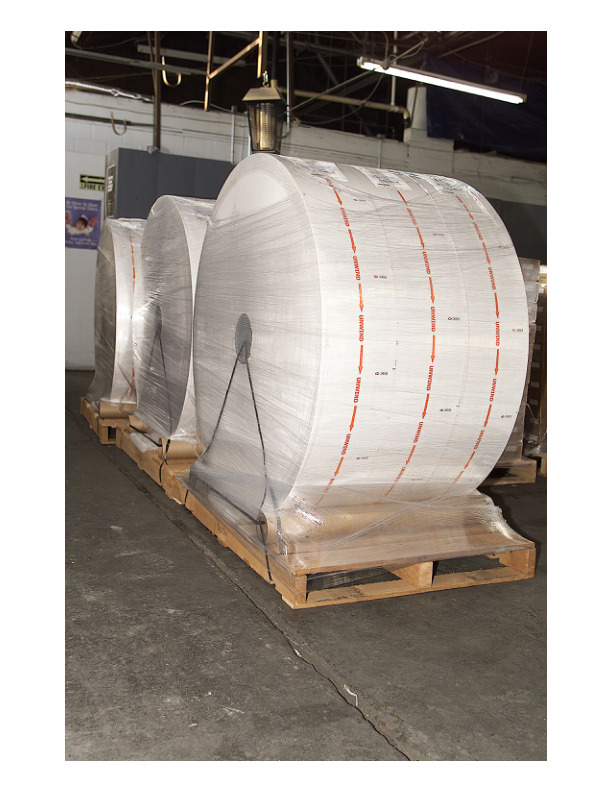The jumbo rolls sector of the printing industry sort of falls into that category — as in, not a lot has changed on the technology side of jumbo rolls. If you’ve ever worked on an order within the jumbo rolls world, chances are things are pretty much how they were then.
What They’re Good For
Before you consider adding everything that comes with jumbo roll capability, you should at least have an end-goal in mind. Knowing the best uses for jumbo rolls, you can decide if and how you want to implement them into your business. Bob Saunders, vice president of sales at Wise, Alpharetta, GA, mentions products like financial statements, statement transactions, invoices, utility bills, checks, pre-printed shells for variable overprinting, and promotional inserts as some of the ways his company uses jumbo roll printing.
“Unlike most print or promo items, jumbo rolls are a niche product and not applicable to most,” Saunders says. “However, when you find a user of jumbo rolls, the dollar volume will be significant.”
To find those users, he says you can look at your existing client base and determine whether there’s an opportunity to add jumbo roll products to the sales. Chances are they’re getting the products from somewhere — why not make the transaction a one-stop shop for them? And if they’re not, you can be the one to introduce them to the idea.

“I would suggest looking at your customer and prospect list,” Saunders says. “If you have a customer that is in [certain markets], there may be an opportunity for statement processing and/or direct mail. If the volumes are large enough, jumbo roll products may be the answer. If not, it’s likely a cut sheet product would be the appropriate product.”
Those certain markets, Saunders says, are things like finance, retail, utilities, insurance, telecommunications, manufacturing and distribution, statement processing houses, direct mail processing houses, and nonprofits.
Some of those customers might have specific needs or questions for you, and that’s where Saunders recommends turning to your manufacturing partners when necessary.
“They can help walk you through questions to ask and information to gather,” he says. “Often, the statement processor or direct mail house has questions or requirements about things such as quality processes, disaster recovery, strict packaging requirements, and logistics. This may require your manufacturing partner to be transparently engaged in the selling process.”
Managing Expectations
Without being present on the printing floor, you might not know everything that goes into the jumbo roll printing process. Tim Sellers, general manager at Ennis-owned Printegra, Fairport, NY, says that a distributor needs to talk with both their manufacturing partners (if they’re not manufacturing the products themselves) and their end-buyer clients to make sure everyone is on the same page.
“Most end-buyers expect to be able to just turn on their machine and have no issues until the roll is done, and that’s just not a reality,” Sellers says. “You’re dealing with paper, you’re dealing with ink, you’re dealing with perfs. It’s going to snap the web once in a while. In talking to other manufacturers and other equipment brokers, the normal would be two web breaks per roll, and there are customers that really expect to run roll after roll after roll with no issues. And that’s just not a reality in this world, to be honest with you. I would say [keep] your expectations within reason.”

The best way to learn about this process, and the many intricacies and variables, is to be present for them, and to come at it with a humble mindset, rather than expecting to be an expert in the first minute.
“Be willing to start out at the bottom,” Sellers says. “It’s easy to run an inkjet machine, but if you don’t know all of the other components that go into it — you don’t know perfing, you don’t know punching, you don’t know throw length, you don’t know paper thickness — you’re going to handcuff yourself with troubleshooting.”
Tales of Success
Both Saunders and Sellers have recent success stories from within their jumbo rolls businesses, which can serve as inspiration whether you’re just starting out in jumbo rolls or have been at it for a long time.
Saunders’ story actually starts with a bit of disappointment: A large jumbo roll application transitioned to black and white paper, and the entire job was printed on inkjet.
“Rather than give up on the account, we worked closely with our distributor partner in the account to uncover new applications to replace our lost revenue,” Saunders says.
“After a few months, that opportunity presented itself, but not without challenges. We had to turn around three to four truckloads of printed jumbo roll product in less than two weeks. The application was a proxy statement for a large financial institution that had to be in the mail by the end of the month.”
Working with all parties involved, Wise was able to get the project across the finish line.
“This not only replaced the lost work, but has proven to increase revenue as the year progressed,” Saunders says. “Persistence and performance paid off.”
At Printegra, a recent job involved a paper label and ID card combination.
“They wanted an ID card for the end-user to be able to have, and then they also had the variable information, the static information, on the paper portion of it to coincide with all of the other information,” Sellers says. “So, getting the print, the ID card, and the peel-off labels all to work for one end-user was a lot of back-and-forth and testing.”
The adhesive proved to be the trickiest part, Sellers says.
“The labels need to adhere to the sheet tight enough, but still be peeled off once it goes through the end-user’s equipment. The labels need to stay on the sheet while it’s flowing through the equipment, so you need to have just enough tack to keep it on the paper, but not too much where it doesn’t peel back off. And then the ID card popping prematurely, where it’s falling out of the form before it finishes traveling through their equipment.”
Final Word
No matter what your applications, and whether you’re new to print or an old pro, there are still things to learn and adjust in an area of print that some might think is static or never changing. While the tech might be the same, approaches and strategies can always change.

